
* As a world war approached in the late 1930s, the Douglas company of the USA designed a twin-engine medium bomber / attack aircraft, which would emerge as the "Douglas Bomber 7 (DB-7)", with the US military designation / name of "A-20 Havoc". Thousands were built, many of them being provided to US allies, and the type proving an asset to the Allied cause. This document provides a history and description of the A-20 Havoc. A list of illustration credits is provided at the end.
* With war fears growing in the late 1930s, in 1936 the Douglas Company of El Segundo, California, began work on a light twin-engine bomber / attack aircraft, the "Model 7A", with the design put together by Jack Northrop and Ed Heinemann. In 1938, the US Army Air Forces (USAAF) conducted a competition for a new twin-engine medium bomber / attack aircraft; the unflown Model 7A design seemed like a good fit -- though it was too small and needed to be scaled up, resulting in the "Model 7B".
Initial flight of the Model 7B was on 26 October 1938. It was a high-wing aircraft of aluminum-alloy construction, with tricycle landing gear -- an innovation at the time. It was powered by two Pratt & Whitney (PW) Twin Wasp R-1830-S3C3 14-cylinder two-row air-cooled radials, with 820 kW (1,100 HP) each, driving three-bladed variable-pitch props.
For low-level attack, the Model 7B could have a "solid" nose, with two 12.7-millimeter (0.50-caliber) and six 7.62-millimeter (0.30-caliber) Browning machine guns, plus a load of small fragmentation bombs in the bomb bay. For the level bombing role, the Model 7B could have a plexiglas nose for a bombardier, with two Brownings in "packages" along each side of the nose, plus a load of general-purpose bombs. Maximum bombload was 900 kilograms (2,000 pounds). In either case, defensive armament consisting of a Browning in a dorsal "birdcage" turret and a Browning firing out a tunnel in the floor.

War was approaching in Europe, and the administration of President Franklin Delano Roosevelt was trying to assist Britain and France to resist Hitler, while keeping the assistance quiet. The Anglo-French purchasing commission was interested in the Model 7B -- with the supposed low-profile dealings on the matter acquiring a high public profile when the Model 7B crashed on 23 January 1939. The pilot was killed, while a French officer who had been on board as an observer was badly injured.
In response to news reports of the accident, isolationists screamed that the US government was scheming to drag America into the looming European war. Incidentally, the USAAF contract competition was canceled because of the crash of the Model 7, as well the crash of the entry from the Martin company. The USAAF would re-evaluate and soon restart the effort.
The Anglo-French purchasing commission continued its activities in the USA, with France ordering a batch of 100 "Douglas Bomber Model 7 (DB-7)" machines in February 1939. The French wanted more armor, fuel, and other improvements, so Heinemann dramatically redesigned the fuselage, making it deeper, with the engines mounted below the wings instead of the middle of them, and the birdcage turret replace by a simple sliding canopy. Initial flight of the first DB-7 was on 17 August 1939 -- a mere six months after go-ahead.
The DB-7 provides a baseline for the A-20 family. It was, as noted, an all-metal aircraft with a high wing mounting PW R-1830-S3C3 radials, and with tricycle landing gear. It had a conventional tail arrangement, the tailplane featuring a strong dihedral; flight control surface arrangement was conventional, with ailerons, a flap inboard and outboard of each engine, elevators, rudder, and trim tabs. All controls were manual, except for hydraulically-actuated flaps. Fuel capacity was 777 liters (205 US gallons), in wing tanks. The tanks were not self-sealing.
All landing gear had single wheels, and retracted backwards hydraulically. There was a bumper under the tail to deal with tail strikes on take-off. Gun armament -- all guns being 7.5-millimeter (0.295-caliber) Chatellerault machine guns, fitted in France -- consisted of four nose guns, in packages alongside a glazed nose, a gun on a flexible mount in the rear on top, another one firing out the tunnel in the belly. The bomb bay was in two sections. Bombload was, as with the Model 7B, a maximum of 900 kilograms (2,000 pounds), though meant short range, and a more typical bombload was no more than 545 kilograms (1,200 pounds).
Crew was a bombardier, pilot, and rear gunner. The bombardier got into the nose through a rear-hinged door underneath, while the pilot clambered up on the wing -- using a fixed stirrup behind the left wing, and handholds in the fuselage -- to get into the cockpit from the top, using a right-hinged door. It is not clear how the rear gunner got in; it appears to have been through the ventral tunnel. The nose glazing was made up of square panels, resulting in a zigzag profile on the lower sides.
There was a little teardrop window on each side of the rear fuselage, to provide light for use of the tunnel gun. The tunnel gun seems ineffectual in hindsight, but it would be retained through subsequent variants, so it seems to have had some value. There was no access between the three crew positions; the rear gunner was given simple flight controls to handle the aircraft if the pilot were disabled -- and, though it seems dubious in hindsight, there are reports that it did work as specified in a few cases.
The initial batch of 100 DB-7s was built at the Douglas El Segundo plant. A second batch of 170 DB-7s were ordered on 14 October 1939, these machines being built in the new plant at Santa Monica. The 131st and later production items featured R-1830-S3C4-G Twin Wasps -- with a two-speed instead of one-speed supercharger, and using 100-octane instead of 87-octane fuel. The new engines provided 895 kW (1,200 HP) each.
BACK_TO_TOP* Following the orders for 270 DB-7s, 100 more "DB-7A" machines were ordered by the French on 20 October, with Wright R-2600-A5B 14-cylinder two-row air-cooled Twin Cyclones, with a two-speed supercharger and providing 950 kW (1,275 HP) each, in lengthened nacelles; perforations were added to the sides of the nacelles, in hopes of improving cooling. The DB-7As also featured an updated landing gear scheme, more armor, and a broader tailfin -- the belief being that greater engine power demanded a bigger tailfin. Two DB-7As were tested with twin tailfins, at the request of the French, who suggested it would improve the rear gunner's field of fire. There was no advantage to the twin tailfins, and no other machines in the series had them.
Initial flight of DB-7A was on 30 July 1940, with production at Santa Monica. Total French orders amounted to 270 DB-7s and 100 DB-7As. The first DB-7s were delivered to Casablanca at the end of 1939, with about 60 having been delivered at the time of the German invasion of France in May 1940. The DB-7s that were in service flew sorties against the invaders, suffering losses. After the fall of France in June, the remaining machines, including all the DB-7As, were delivered to Britain instead, to serve with the Royal Air Force.
Surviving French DB-7s flew to Algeria. On 3 July, after the British failed to persuade the French Navy there to take their warships to where the Germans couldn't control them, the Royal Navy struck at French naval assets in Africa, inflicting serious damage. In retaliation, the French DB-7s conducted a raid against Gibraltar on 18 July -- inflicting no damage, suffering no losses.
The DB-7/7A machines in RAF service were fitted with British 7.7-millimeter (0.303-caliber) machine guns, and had controls modified for British usage -- the French and British had throttle controls that worked in opposite directions, for example. As detailed later, the British would give the names "Boston I", "Boston II", and "Havoc I" to these aircraft in RAF service, in a confusing pattern of variations.
* In February 1940, Britain placed an initial order for 150 "DB-7B" machines, the order quickly being upped to 300. The DB-7B featured:
The DB-7Bs were given the name of "Boston III" in British service. The French had also placed an order for 480 "DB-73" machines, with half to be built by Douglas in Santa Monica, half by Boeing in Seattle. None were delivered to the French, the contract being taken over by Britain after the French collapse, to be completed as DB-7B / Boston III machines.
Along with a replacement for a DB-7A that was lost in a crash, that gave total orders of 781 DB-7Bs, with 541 built in Santa Monica, and 240 built by Boeing. The British were supplied the DB-7Bs from August 1941 to January 1942, going into combat in early 1942. Not all of them actually went to Britain, with the USAAF requisitioning over 350 of them; it is not clear what the USAAF did with them. Small numbers of DB-7Bs were obtained by other nations:
The Dutch DB-7Bs were substitutes for a batch of 48 "DB-7C" machines that were to have replaceable solid / glass noses and torpedo gear. The Dutch East Indies having fallen, they were never built as ordered; the story is unclear, but it appears they were produced as DB-7Bs and handed off to the USSR.
* In parallel with activities on the DB-7s, the USAAF had issued a new requirement for a medium bomber / attack aircraft, with Douglas submitting what amounted to a variant of the Wright-powered DB-7A. Douglas won the contract, receiving an award in June 1939 for a batch of 63 "A-20" machines -- for high-altitude level bombing -- and what would turn out to be 143 "A-20A" machines -- for medium-altitude level bombing, and low-level attack. The USAAF would at least informally adopt the name "Havoc" for the A-20, though it's unclear how much enthusiasm there was for the name.

Both the A-20 and A-20A were variations on the DB-7B, with the nose glazing featuring a diagonal edge. They were armed with 7.62-millimeter Browning guns, with one in the rear dorsal position, and another in the tunnel position; later machines had twin Brownings in the dorsal position. They also had four fixed Brownings in the nose, and could in principle be fitted with a fixed rearward-firing Browning in the back of each engine nacelle, to be fired by the rear gunner, using a foot pedal. The rearward-firing guns proved as impractical as might be thought -- and to the extent the rearward-firing guns were installed, they were generally yanked out in the field. All were built in by the El Segundo plant, being the last of the A-20 family built there.
The A-20 was to have Wright R-2600-7 engines with turbochargers, but the turbochargers proved bulky, troublesome, and ineffective. Only one A-20 was flown with the turbochargers. The initial A-20 was then rebuilt as the first "P-70" night fighter -- discussed later -- with 59 more A-20s being completed as P-70s. The other three were built to the "F-3" reconnaissance configuration, including one "XF-3" and two "YF-3" machines. These three were apparently used for further trials. The bottom line was that there was really only one A-20, and the A-20 never entered operational service.
Initial flight of the A-20A was in September 1940, with deliveries from November. It was powered by Wright R-2600-11 Double Cyclones, with 1,195 kW (1,600 HP) each. The first 17 lacked armor protection and self-sealing fuel tanks, with those items added to later production of A-20As. One A-20A was supplied to the US Navy for evaluation as a fast target sleeve tug, being designated "BD-1". The A-20As would eventually be replaced by improved variants, to be relegated to the target-tug role.
* In October 1940, the USAAF ordered 999 "A-20B" machines -- as well as 775 "O-53" similar reconnaissance machines, though that part of the order ended up being canceled. The A-20Bs were produced at the new Douglas factory in Long Beach, California; they would be the only A-20s built there, all later production being in Santa Monica. The US Navy, having been impressed by the BD-1 target tug, obtain eight A-20Bs as "BD-2" target tugs. 665 A-20Bs were supplied to the USSR.

While the A-20A was a variation on the DB-7B, the A-20B was actually a variation on the DB-7A -- light armor, no self-sealing tanks, and the stepped nose glazing. It added an escape hatch on top of the nose; the bombardier had troubles getting out of the aircraft through the under-nose hatch after a belly landing. It was the only A-20, as such, with the stepped nose glazing.
The A-20B had Wright R-2600-11 engines, plus defensive armament of two fixed 12.7-millimeter (0.50-caliber) Brownings in the nose, one 12.7-millimeter Browning in the rear dorsal position, and a 7.62-millimeter Browning in the ventral tunnel position. Early productions had the cooling perforations in the engine cowling like the DB-7A, but they were deleted in later production, having proven ineffective. Late production could be fitted with a 530-liter (140 US gallon) auxiliary fuel tank in the bomb bay. It could be fitted with the under-fuselage ferry tank as well, as could all subsequent variants.
* The subsequent "A-20C" variant was a follow-on to the A-20A, and looked much like it. It was generally equivalent to the DB-7B, having R-2600-23 Cyclones, self-sealing tanks, more armor, and seven machine guns. Provision for the rear nacelle guns was deleted. From production block 5, it could carry a torpedo under the centerline. It was primarily built for export, being provided to the UK under Lend-Lease -- as opposed to purchase -- and armed with 7.7-millimeter guns, this configuration being designated "Boston IIIA" in British service. USAAF A-20Cs had 7.62-millimeter Brownings.
A total of 948 A-20Cs was built, with 808 built by Douglas at Santa Monica, a and 140 built by Boeing in Seattle. They were the last Boeing-built A-20s, that company having built a total of 380. Most of the A-20Cs were shipped to the USSR.

One A-20C was heavily armored, to be as a test platform to evaluate "frangible" ammunition, to be used for training anti-aircraft gunners, with the projectiles fragmenting when they hit something. This scheme was actually put into service, with heavily-armored Bell RP-63 Kingcobras being the targets. They had a light that flashed when a hit was scored, so they were known as "Pinballs". Another A-20C was used to trial tractor-tread landing gear; it proved as dubious as it sounds.
There were plans for a lightweight "A-20D", but it never happened. There was an "A-20E", which was a designation applied to 17 stripped-down A-20As used for training and trials. The "XA-20F" was an A-20A with a fixed 37-millimeter cannon in the nose, and rear remote-controlled dorsal / ventral turrets with twin 12.7-millimeter Brownings. The XA-20F was effectively a trials machine for the follow-on Douglas A-26 Invader. Sources also mention an "XA-20B", a conversion of an A-20A with twin turrets; it may well have been the XA-20F in an earlier configuration.
USAAF A-20s in the field were often modified with "gun noses", replacing machine guns for the bombardier, and so the "A-20G", first delivered in early 1943, had a solid gun nose as well. It also had more armor and R-2600-23 engines with 1,200 kW (1,600 HP) each. Along with a 12.7-millimeter Browning in the dorsal position and a 7.62-millimeter or 12.7-millimeter Browning in the ventral tunnel position, the A-20G had six guns in the nose -- originally four 20-millimeter cannon in a 2x2 arrangement, with two 12.7-millimeter Brownings under the nose. Bomb load remained 900 kilograms (2,000 pounds), with the A-20G able to carry a torpedo on the centerline. An external belly tank could be attached for ferry flights.
___________________________________________________________________
DOUGLAS A-20 HAVOC:
___________________________________________________________________
wingspan:
18.7 meters (61 feet 4 inches)
wing area:
43.1 sq_meters (464 sq_feet)
length:
14.6 meters (48 feet)
height:
5.52 meters (18 feet 2 inches)
empty weight:
7,270 kilograms (16,030 pounds)
loaded weight:
10,945 kilograms (24,125 pounds)
max speed at altitude:
525 KPH (325 MPH / 280 KT)
service ceiling:
7,200 meters (23,700 feet)
range:
1,520 kilometers (945 MI / 820 NMI)
___________________________________________________________________
Apparently the cannons tended to jam, so after the 250th production A-20G, they were replaced by 12.7-millimeter Brownings. After the 750th production machine, the 12.7-millimeter dorsal gun was replaced by an electrically-driven Martin turret with twin 12.7-millimeter Brownings, with the fuselage widened by 15 centimeters (6 inches) to accommodate the turret.

A 12.7-millimeter gun was made standard in the ventral position. There was a window on top of the fuselage behind the turret to let light into the ventral position. With the introduction of the turret, a second rear gunner was added to handle the ventral gun. Two stores pylons were also added outboard on each wing, allowing a total bomb load of 1,800 kilograms (4,000 pounds), though only over short ranges.
Most of the A-20Gs with cannon were exported to the USSR. No A-20Gs were exported to Britain, the British having no interest in the Boston in the strafer role. The A-20G was the most heavily-produced A-20 variant, with 2,850 built in Santa Monica.
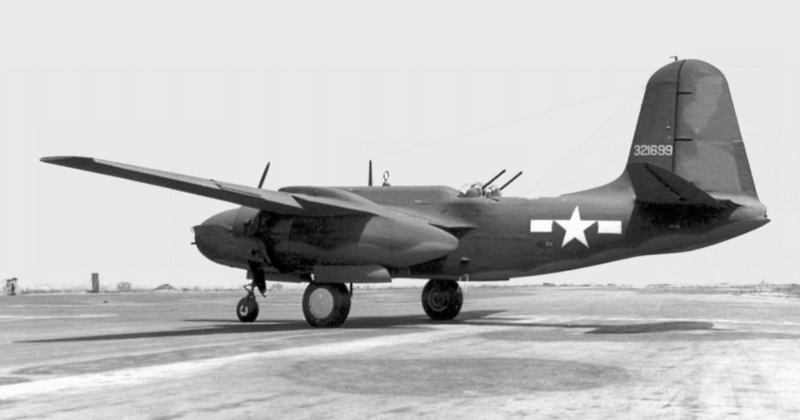
It was followed by the "A-20H", which was much the same as a late-production A-20G, but with more powerful Wright R-2600-29 Twin Cyclones, providing 1,270 kW (1,700 HP) each. One block of A-20Hs was built with the older R-2600-23 engines, fitted with flame dampers, suggesting they were intended for the night intruder mission. 412 A-20Hs were built in 1944. One was experimentally fitted with tracked landing gear. The scheme was dubious in appearance, and was not fielded.
* While the USAAF preferred to use the A-20 for low-level attack in the Pacific theater, in Europe, it was generally used as a medium level bomber. The A-20G didn't have a bombardier, which made it unsuitable for level bombing. The result was that the A-20G was modified with a transparent nose -- made of molded plexiglas, with little framing -- for a bombardier, this variant being designated the "A-20J".
Two 12.7-millimeter Browning nose guns were retained in "cheek" installations. It seems they were often removed in the field, being useless in the level bombing role. The A-20J tended to operate as a "lead bomber", leading a flight of three A-20Gs, all dropping bombs on a signal from the lead bomber. 450 A-20Js were built in Santa Monica, in parallel with later A-20G production. 169 were delivered to the RAF as the "Boston IV".

The last production A-20 was the "A-20K", which was the same as the A-20J, but with R-2600-29 engines. 413 were built at Santa Monica to end of manufacture of the series in 1944, with 90 delivered to the UK as the "Boston V". Forty-six A-20J and A-20Ks were modified to as "F-3A" night reconnaissance machines with a K-19B camera, four flash bombs, and with the ventral tunnel gun deleted. A total of 7,098 A-20s machines had been built by Douglas, while 380 had been built under license by Boeing, for a total of 7,478.
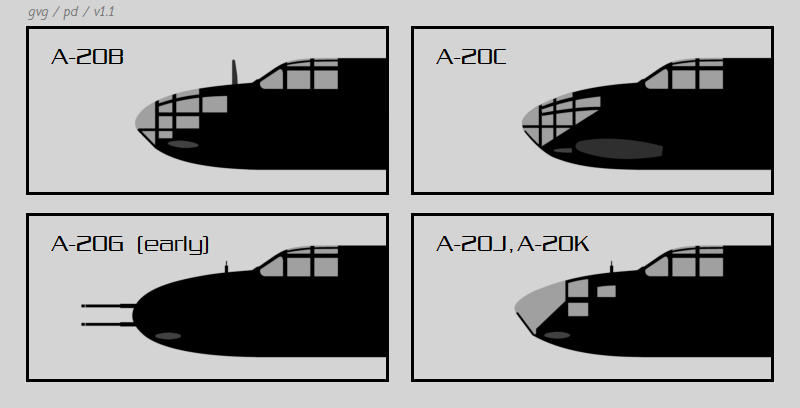
* As mentioned earlier, 60 of the 63 A-20s built were actually completed as P-70 night fighters, which were given the name of "Nighthawk". They were painted black, and had SCR-540 longwave radar, that being a copy of the longwave British AI (Airborne Intercept) Mark IV radar. The SCR-540 had a transmit dipole on each side of the fuselage under the canopy, plus an "arrowhead" receive antenna on the nose. There were also two small tandem slanted aerials on top of the left wing, possibly for an identification friend or foe (IFF) receiver.
They were armed with four 20-millimeter cannon in a belly pack, fitted underneath the bomb bay, with 120 rounds per gun. The upper part of the bomb bay was fitted with an auxiliary fuel tank, with a capacity of 950 liters (250 US gallons). The radar operator sat in the rear gunner's position; it is unclear if the rearward-firing weapons were deleted, though they probably were in practice.
In 1943, 13 A-20Cs and 51 A-20Gs were converted to the "P-70A" configuration, which also had SCR-584 radar -- but six 12.7-millimeter Brownings in the nose, with the radar gear relocated to the bomb bay. Some P-70 / P-70A machines served in the South Pacific, but they had an undistinguished career, their lack of turbochargers being a particular limitation. They were replaced by the much-superior Northrop P-61 Black Widow from 1944. The rest served as trainers in the US.
One A-20G was converted to "P-70B-1" configuration, with US-made "centimetric" (microwave) SCR-720 radar instead of SCR-540 radar, the centimetric radar being a great advance over the longwave radar. It had three 12.7-millimeter Brownings in an oversize blister on each side of the cockpit, for a total of six in all. 105 A-20Gs and A-20Js were converted to "P-70B-2" configuration, with centimetric radar, but 6 or 8 12.7-millimeter Brownings in a belly pack. They were used as trainers stateside; P-70s in the training role were, at least informally, referred to with the designation of "TP-70".
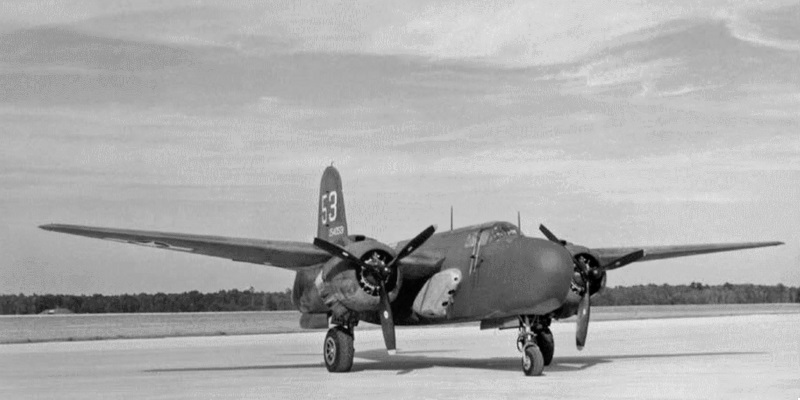
The three A-20s converted to F-3 test platforms led to conversion of 46 A-20J and A-20K aircraft to "F-3A" night reconnaissance machines. The two nose guns were removed, while cameras were mounted in the nose and the rear of the bomb bay, with photoflash flares dispensed from the front of the bomb bay. They operated in Europe from the spring of 1944.
BACK_TO_TOP* In service, the A-20 was generally liked, being sturdy and reliable, with fighter-like performance; indeed, the single-seat cockpit made it feel much like a fighter. It was fast for its class, responsive and agile, with particularly good engine-out performance. The tricycle landing gear and the forward positioning of the cockpit gave the pilot an excellent field of view during taxiing. Pilots found it a "sporty" aircraft.
The A-20 was in the thick of the action from Pearl Harbor, A-20s stationed in Hawaii coming under attack on 7 December 1941. It would continue to fight in the South Pacific all through the war. First blood for the A-20 in the European theater was in Operation TORCH, the invasion of North Africa, in the fall of 1942. The A-20 would eventually fly with seven USAAF bomber groups: three with the Fifth Air Force in the South Pacific, one with the Twelfth Air Force in Italy, and three with the Ninth Air Force in Britain.
The A-20 would prove particularly useful for the USAAF in the South Pacific. As mentioned, A-20Cs, obtained by the Fifth Air Force, were generally kitted up with fixed nose guns for low-level attack, which would lead to the development of the A-20G. A-20s would attack Japanese airfields in parallel, strafing as they came in to suppress anti-aircraft fire, to dump "parafrags" -- parachute-retarded light fragmentation bombs -- on Japanese aircraft. The parafrags would detonate after the bombers had left. There were also experiments with fitting A-20s with underwing "bazooka tube" launchers for 11-centimeter (4.5-inch) unguided rockets, but the launch tubes proved too "draggy".

The A-20 also proved an excellent anti-shipping weapon, using the "skip bombing" technique. That involved coming in at mast height, and skipping a bomb into the side of a ship. Such low-level attacks were hazardous, a series of images showing an A-20 hit by its own bouncing bomb, with fatal results. In early March 1943, skip-bombing A-20s, working with other Allied attack aircraft, slaughtered a Japanese troop convoy in the Solomons, with the Battle of the Bismarck Sea being a brutal demonstration of the effectiveness of air power.
In Europe, as mentioned, the A-20 was mostly flown in the level bombing role. It performed a large number of sorties in the ramp-up to D-Day -- the invasion of Normandy on 6 June 1944 -- and in tactical support afterward. By the end of the war, the A-20 was being replaced by its better descendant, the Douglas A-26 Invader, though A-20s remained in service to the end of the fighting.

* Also as mentioned, the British Royal Air Force was a major DB-7 / A-20 user, having flown the type in combat before America entered the war. Of the DB-7s taken over from the French order, a handful were used as trainers to familiarize RAF pilots with tricycle landing gear; they were named "Boston Mark I". 134 others, with the uprated R-1830-S3G4-G engines, were originally accepted into service as "Boston II" bombers -- but they weren't satisfactory in that role, it seems largely because of limited range. Other than the Boston I trainers, the Bostons were quickly adapted to other roles, under the "Havoc" name:
The DB-7As were similarly converted to "Havoc II (Night Fighter)" configuration -- with AI Mark IV radar, 12 7.7-millimeter machine guns in the nose, and more fuel tankage -- and "Havoc II (Turbinlite)".
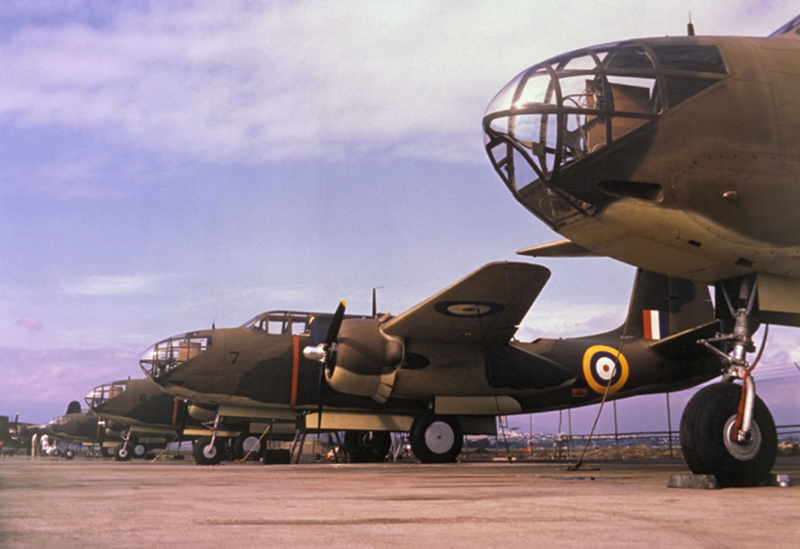
The DB-7Bs -- and a few of the DB-7As not converted to night fighters -- obtained by Britain were designated "Boston III", generally being used as mid-level bombers, though some were used as night intruders and with some Turbinlite conversions as well. The British seemed to have invested a good deal of effort in the Turbinlite scheme before they realized it was a loser.
The RAF obtained the A-20C as the "Boston IIIA", typically using it in the mid-level bomber role. As mentioned, the RAF didn't have any need for the strafer A-20G, but they obtained 169 A-20Js as the "Boston IV". RAF Bostons were flown in North Africa, the Mediterranean, and Western Europe -- in particular, distinguishing themselves during the Normandy invasion campaign of 1944. Some of RAF Bostons were actually flown by Free French and South African squadrons, attached to the RAF. The RAF acquired a total of 1,166 Boston series aircraft.
* The Soviet Union had contacted Douglas in the fall of 1939 to buy a batch of DB-7s, and obtain a license for their manufacture. That fell through after the Soviet invasion of Finland in the winter of that year -- but when the USSR received Lend-Lease assistance in September 1941, the A-20 was seen as an important contributor to the Soviet war effort, with over 3,000 pledged, and over 2,900 actually delivered -- a substantial number of them being brought over by the Siberian air route, though they were obtained through other routes as well, including Iran. The Soviets called all variants of the A-20 the "Boston".
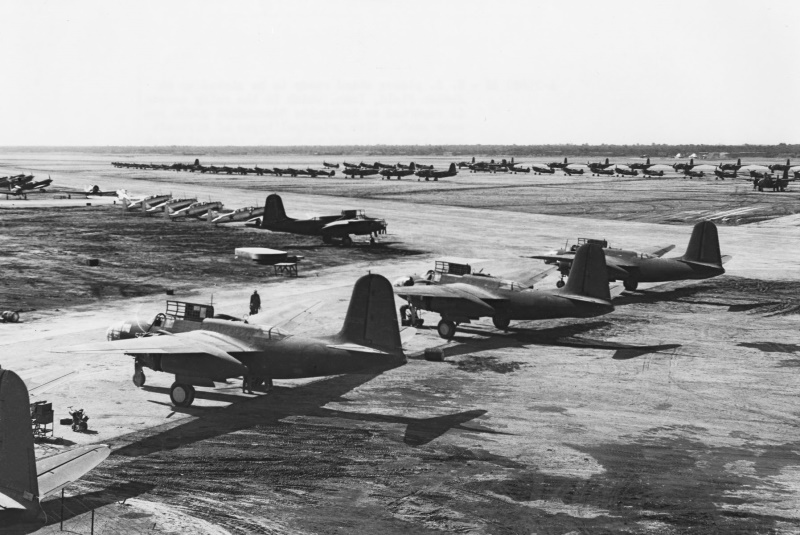
Initial deliveries were of machines that had been originally earmarked for Britain, including 77 Boston III / DB-7Bs and 103 Boston IIIA / A-20Cs. They were designated "B-3" in Soviet service, going into combat in the spring of 1942. The Soviets initially used them in the low-level attack role, but they weren't seen as the best tool for that work -- they had the very tough Ilyushin Il-2 Shturmovik for that job -- and they were switched to the medium bomber role, in Bomber Air Regiments. The lack of a navigator's station in the A-20G was troublesome to that end, so some of the A-20Gs were modified, the nose guns being removed and a navigator's station installed, with some windows crudely cut into the nose.
A-20s in Soviet service were typically refitted with Soviet machine guns or cannon, plus eventually with a Soviet UTK turret, featuring a 12.7-millimeter machine gun, in the dorsal position. There were apparently also fits of a turret with a 7.62-millimeter machine gun, or two 12.7-millimeter machine guns. A few were used in the night intruder role, with a gun pack under the bomb bay with twin 20-millimeter and twin 12.7-millimeter machine guns; the downward angle of fire of the guns could be changed, to allow an A-20 to strafe targets while flying level. A-20 bomb racks were modified to handle Soviet munitions, and some were kitted up to carry unguided rockets under the wings.
The Red Navy was particularly fond of the A-20, using it for photo-reconnaissance, and as a torpedo bomber and mine layer in the Baltic and the Black Sea. A number of A-20Gs were also converted to a night-fighter configuration, with Gneys-2 radar, but they didn't prove very effective. Some Soviet A-20s were converted to dual-control trainers, with the instructor's controls in the nose position. The Soviet A-20s stayed in frontline service through the end of the war.
Australia obtained 69 Havocs from 1942 to 1944, including nine A-20As, 22 DB-7Bs, nine A-20Cs, 28 A-20Gs, and an A-20Js. They occasionally fought alongside USAAF A-20s. Brazil also obtained 30 A-20Ks in 1944, but they didn't see combat.
* After the conflict, the A-20s were quickly retired from Western service, and generally scrapped, though a few were flown as utility machines for a time. The Soviets continued to fly them into the early 1950s. A number of A-20s survive as museum displays; one A-20G is still flying, making appearances at airshows.
* The following list summarizes DB-7 / A-20 variants and production:
* Sources include:
Online materials provided by aviation enthusiast Joe Baugher were also consulted.
* Illustrations details:
v1.0.0 / 01 nov 19 v1.1.0 / 01 dec 19 / General update. v1.2.0 / 01 sep 21 / Clean-up, revised illustrations. v1.2.1 / 01 jul 23 / Review & polish. v1.2.2 / 01 jun 25 / Review & polish. (*)BACK_TO_TOP
